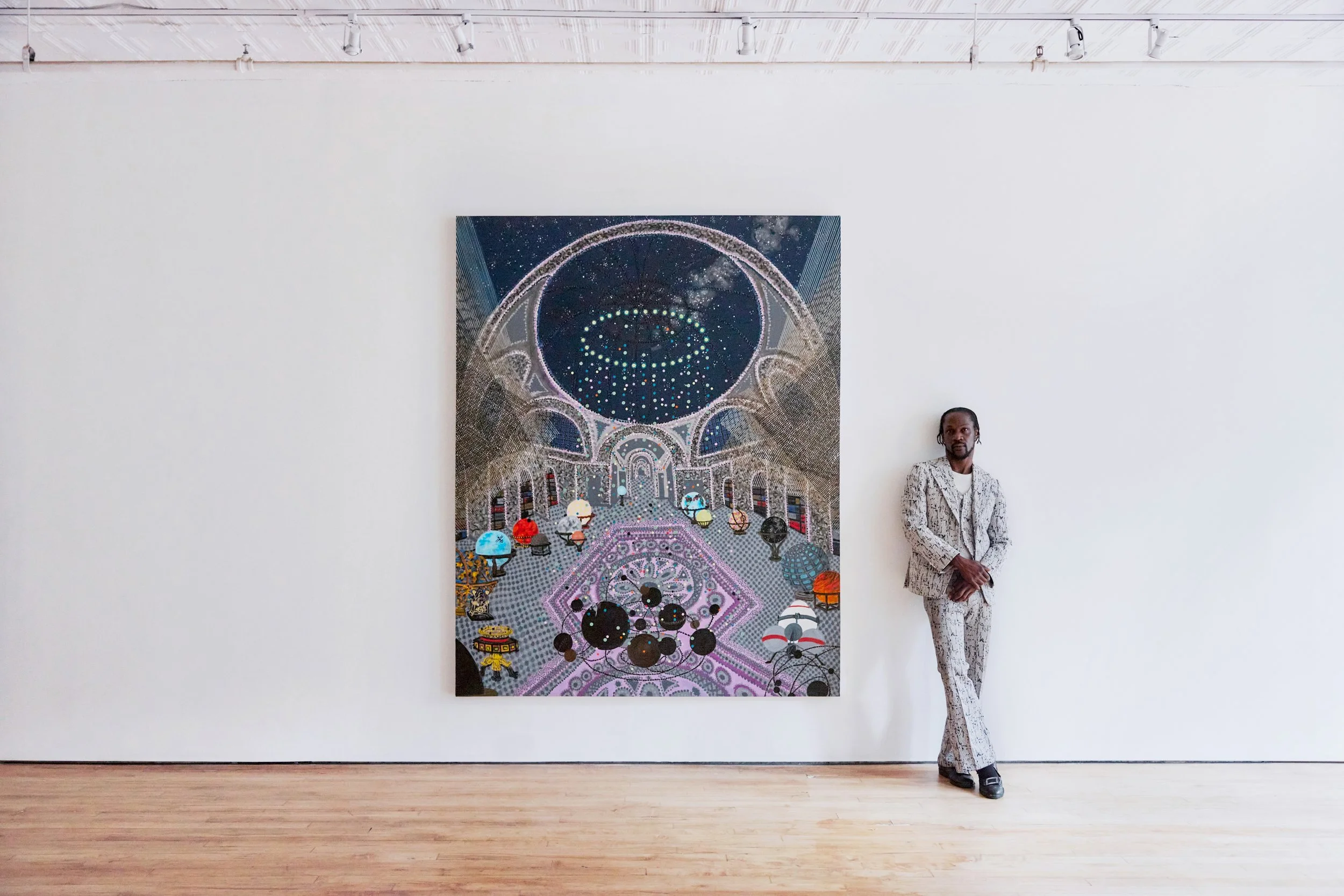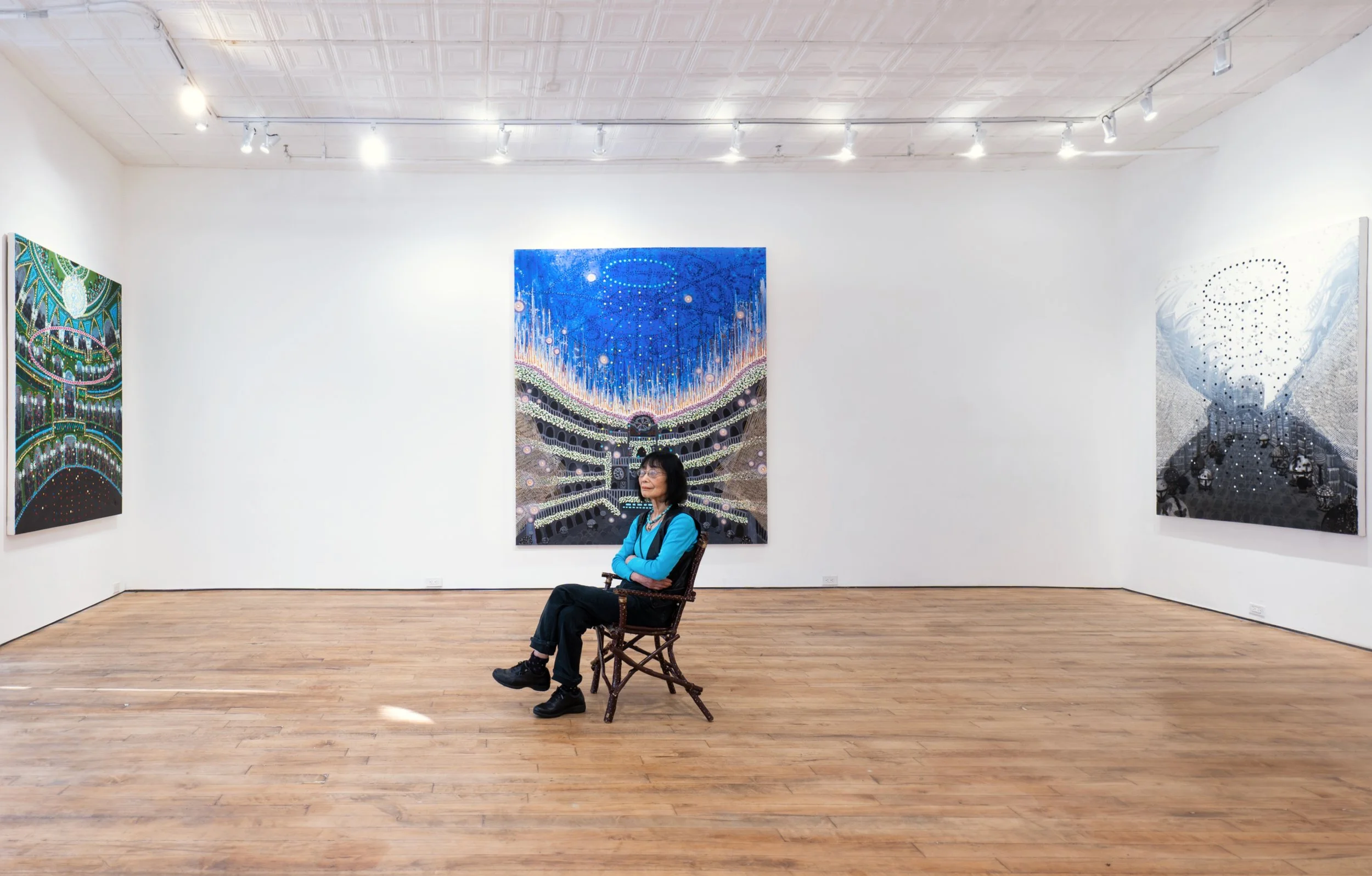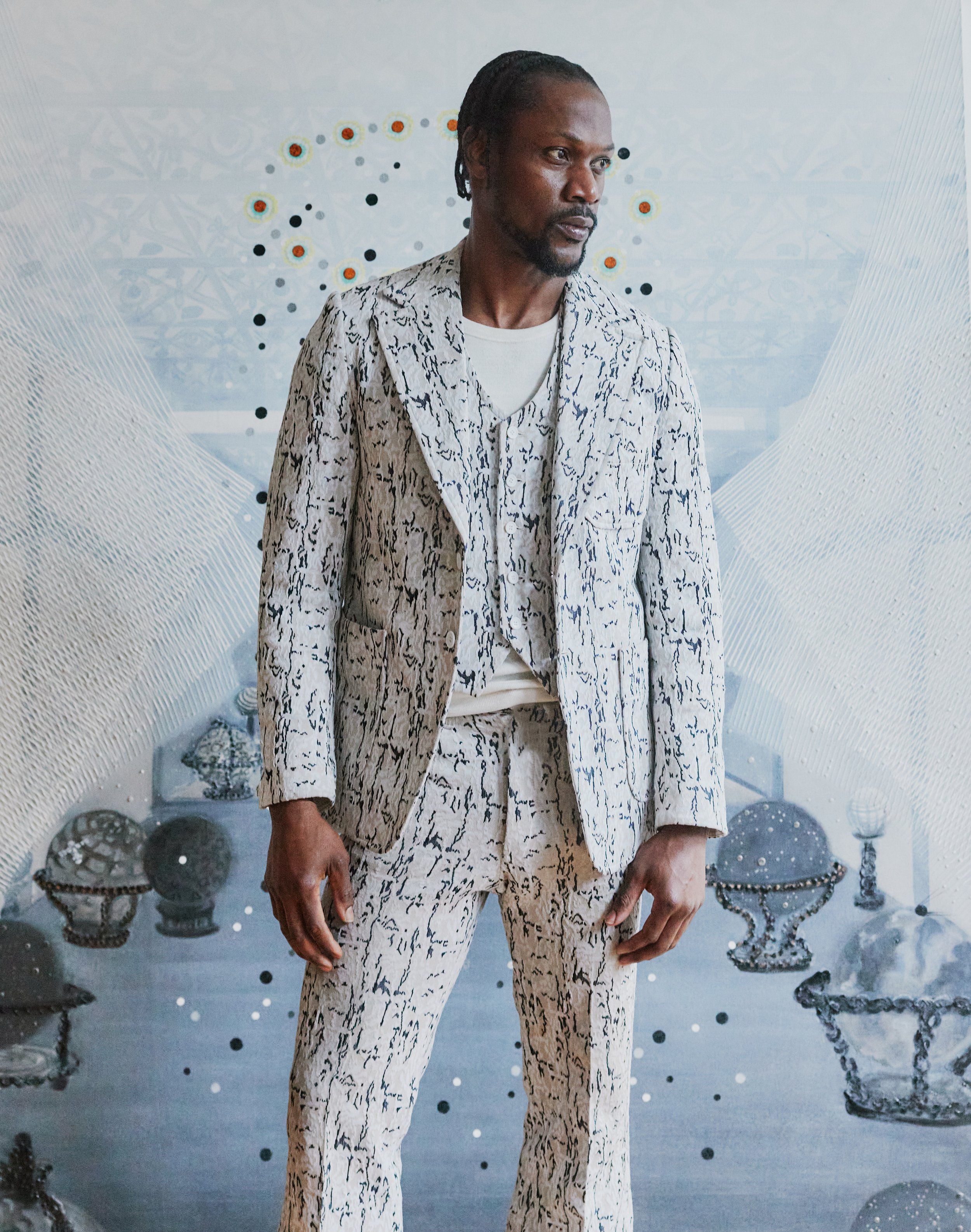Whitehot Magazine: A conversation with Onyedika Chuke, artist and curator of STORAGE
Onyedika Chuke. Credit: Emiliano Granado.
By DAVID JAGER November 21, 2023
Onyedika Chuke is one of Tribeca’s most promising up and coming gallerists. He has been previously featured and reviewed in Frieze, Artforum, Artnet the NY Times and the LA times. Born in Nigeria and raised in NY, he graduated from Cooper Union in 2011. Chuke came up in the art dealing world for fifteen years before striking out on his own towards the end of the pandemic. As the owner of STORAGE, tucked away on the fourth floor at 52 Walker Street, he has hand restored an old school gallery space that- in addition to bold new work- caters often to mid or late career artists with obscured histories. Chuke enjoys taking chances based on gut feelings and genuine love of work, a rarity in an increasingly market driven, blue-chip art world. We sat down with Chuke at STORAGE, which is currently showing the paintings of Michiko Itatani. They will also be at booth C-104 at the next NADA MIAMI, featuring Itatani, Jeff Way, Adam Lupton and Baxter Kozoi. We talked about his past, the mission of his gallery, art that matters, and the murky follies of the algorithmic and market driven art world.
DJ: You started dealing with Susan Sheehan.
OC: Yeah, she was modern and post-modern, American masters, you know. She thought there should be room for other people. she started in 1985. Works on paper, and offsets. So, Ellsworth Kelly...
DJ: Ed Ruscha?
OC: Yes, Ed Ruscha, a lot, Lichtenstein, McLaughlin, Warhol. I was an art student freshman year at Cooper, and I met her through Richard DesRoche, of CRG, who was a dealer to Jim Hodges.
He was almost about to work with Julie Mehretu, when I met him, but eventually she would go on to work with Christian Haye (founder of the RAW institute), and probably one of the only other black dealers I get compared to. The biggest difference between Haye and myself is that I dealt art for 15 years before opening my own gallery. I am an artist who happens to love business. This is not the gallery of an artist trying to figure shit out. I intend to be critically responsible for people’s work, as well as financially responsible for their survival…
DJ: Right
OC: I want to be able to help the artists that I care about by remaining sustainable. And to do this I had to learn first-hand, how to challenge the market of other artists.
Michiko Itatani. Credit: Courtesy of the Artist and Storage.
DJ: How do you view that whole process? Of exchanging works on the market? Tracy Emin recently said “Think of exchanging your artwork directly for things that you want. Not money. A painting for a television, for instance. Sometimes my students come to my house and say ‘You exchanged your art for a house?” and I tell them “Yes!” What is your approach?
OC: I think that’s a really good way to look at it. I made these drawings that Susan Sheehan, Richard DesRoches, Jim Hodges- they all looked at them. I had spent six months making them. I sold two. And when I sent them out, I imagined they were dream catchers? That they would work like talismans, bringing me things I needed. I think of that as a healthy way to think about things that you want. It doesn’t necessarily have to be, uh, more money…
DJ: No.
OC: Art brings other forms of resource. It could be love, relationships, understanding, conversation, other things. And at this gallery, I feel like we try to move past that ‘I want’ aspect that dominates the art world. Of people just wanting art world flex, something sexy. We are getting people to slow down, to stop wanting first and instead really look at art. To see art as a proposition through which one can reconsider society. And if someone in the gallery slows down and connects to it, then that’s great. Both the owner and the artist get to have other opportunities. To have more conversations and make other things.
We’ve moved past wanting to be the gallery that makes the most money. What we really want is impact. As much cultural and communal impact as possible. But we do live in a very hyper capitalist environment, and this gallery, in Tribeca, is in a sea of second and third run galleries. The descendants of flagships elsewhere.
DJ: Right.
OC: I guess if we aren’t framing the sale of art monetarily… I’d say my goal is to exchange the work for a conversation, for recognition for the artist. I want the people who collect with us to have things they think of as canonically interesting… and also art that represents something they really believe in. So that they will share it, talk about it.
DJ: Canonically
OC: Canonically. Yeah. Not ‘Is this great or timeless?” I couldn’t give a fuck about history in that sense. But it is important to me if something is made in response to an ongoing conversation, to a dialectic that artists really care about.
DJ: If it is in dialog.
OC: Yes, if it is in dialog with something interesting, vital.
DJ: And there are so many different strains of history.
OC: Very much so.
But back to what matters in art and what matters for me. One of my mentors Lyle Ashton Harris, I met him in 07 about the same time that I met Susan Sheehan. I interned for him at his studio, before I started Cooper. He was this very interesting, tough and mothering figure, that I absolutely loved to death. And he would ask me “What is at stake, in your work?” and I asked him “What do you mean?” and he would ask insistently again “What’s at stake in it? If you don’t know what’s at stake in your work, there’s no reason to make it.”
DJ: Yeah
OC: He was very tough. He had to be. He was part of that Whitney show in 94’, called ‘Black Male?” with Glen Ligon. He was one of those first wild, queer black artists. You know, back then, people were literally beat up for being black and gay. So he had to know what was at stake in his work. And there was the AIDS crisis, losing friends. So he asked me that question about my work. Now, as a gallerist, I get to ask the same question: what is at stake in our practice of the gallery?
Also, what is the nature of our artists relationship to history…because many of our artists are professors, so they are directly in line with history- even if only because they are teaching it. Itatani teaches at the Art institute of Chicago. But traditionally history belongs to artists the market has recognized. If no one had bought Pollock, he would never have been in the history books. So another mission of the gallery is represent a strain of history that rarely gets told.
DJ: Of course. There has to be a patron, right? Like Peggy Guggenheim.
OC: Right.
DJ: She made so much of that possible. Or Thelonious Monk with the Baroness Panonica Rothschild.
OC: Exactly. History is bought and sold. We see it a lot. Art rises or falls with the market. And artists are either forgotten or revived based on their performance on the secondary market…
DJ: So you’re pushing against the market driven approach to art.
OC: It’s this context that keeps returning to haunt us. How much did this sell for at auction? Did it break records? We fall back into it, and it keeps bringing up the same problems.
DJ: Do you have any opinion of ‘Masterworks’? The company that sells shares of high-end contemporary artwork as an investment?
OC: Yeah, it’s like, from a business perspective, as an entrepreneur, it’s interesting. I met one of the founders. I have my thoughts on it. But these kinds of projects only solidify the market. Works beneath a certain value, the so called ‘no names’, get forgotten. The cut-off point is under a hundred thousand?
Onyedika Chuke. Credit: Emiliano Granado.
DJ: Yeah.
OC: I do believe the prominence of certain brands are shaped this way, and we are living in a world of algorithm, an algorithm that shapes what we want. We are living in a world where people become more and more enamoured of things that other people want. Which is usually determined by the market value of something. Aesthetics gets lost.
It makes my job as a dealer that much more important. But it makes my job as a tastemaker incredibly hard. It’s so difficult to convince people to value art they have never heard about before. To say “hey, this is an artist is also contemporary, like the art in Masterworks, but it’s actually just $50,000. So, I get asked “Well, how is this important?”
DJ: There’s this whole other thing, also, with algorithms in the art world. Ben Davis, senior critic at Artnet and Dylan Rodriguez, the sketch artist with a million followers on Tik Tok.
OC: Right.
DJ: Rodriguez has a massive viral following, so Davis does a perfectly reasonable, art world style review. And Rodriguez was so upset by the review he sent a twitter army of trolls after him, saying “Davis you’re fat, you’re ugly, you don’t know art.” Really wild.
OC: Yeah, it’s a whole new world.
DJ: And Rodriguez doesn’t need the gallery system.
OC: No! He doesn’t. And I deal with artists with that perspective. That say ‘I don’t’ really need a gallery.” I just say “Cool, I wasn’t looking for you.”
But I’m open to all sorts of approaches. If you come to me and say “I want to make the world’s most successful poster art”, I’d say ‘Amazing.’ If you say “I just want to make non-commercial sculpture”, I’d say “Amazing’ too. I really don’t care. If your art has a position and you know what’s at stake, I’m there.
The fight between Ben Davis and TikTok is interesting because it shows us how much the art world is divorced from so called reality. From what is publicly consumed art compared to blue-chip galleries- The galleries that say “this is good and that is bad.” Galleries will go after a writer just like Tic Toc and ask “Why did you write this?” It’s just the etiquette that is different.
DJ: Do you court controversy?
OC: I’m not a cancel culture guy. I don’t have an agenda. I’d rather cruise down the middle and see both sides.
DJ: One of the problems are that large commercial algorithms are driven by simple narratives. Ben Davis was just trying to write an art world critique of a global viral artist, a different type of artist. But the myth of the bald snob vs the brave young artist from Queens is too good to resist.
OC: But gate keepers, snobbery, the history of all that still does exist. You know, the salon des refusees, the French Academy. It still exists now, but subtly. There are a class of people who spend tens of thousands of dollars each month with ease, and these are the people who buy art. They are not the same as your average blue-collar person. Ultimately, money hasn’t changed. It’s the ultimate gatekeeper.
DJ: But the New York art world does give a real feeling of egalitarianism. Of anyone being able to walk up to anybody, talk to anyone, regardless of their position. Millionaires dressing down.
OC: Yeah, that’s cute and all.
DJ: But I do sense there is an invisible wall.
OC: Of course. I do think NY is the best at it, what you’re describing. Making it feel as open and equitable as possible. But you know, when you go to the opening, the exhibition is free, sure. But there’s a dinner afterwards. So anyone can walk in free, but how much farther can you go?
DJ: Right.
OC: And you can have money, sure. But is it the right type money that allows you to have this art? And even if you have a lot of it, have you spent it on things before that allows you to let us sell you this thing that you want? So, there are walls.
DJ: Do you have the correct pedigree that allows you to own this Morandi.
OC: Exactly. And I think the art world thinks that because it is open and very liberal- liberating- it stands for some societal openness. But it’s not. I think the world’s worst problems are actually more present in the art world than they are elsewhere. But as we are about fiction production, many of us buy into it, saying artists and collectors are the most open people. When in fact this isn’t always the case.
DJ: I’ve always thought of some contemporary art as a way for the wealthy to externalize a moral conscience, in the form of the work. “I understand that we are in hedge funds, and possibly conflict diamonds and fentanyl, but we have this ironic anti-capitalist painting on the wall…which shows you we’re in on the joke…”
OC: Yeah. But later you can also take that work and put it back on the market, make more money on your joke, or you can write it off. It’s just that there is a lot of gray. There’s just so much gray.
DJ: Yeah.
OC: I don’t think the art world is democratic, and democracy has its flaws to begin with, but I still think it’s an interesting space, the art world, the gallery world, and its where I choose to experiment.
DJ: So your space is here to counter all of that.
OC: I don’t have any illusions. I understand that I’m a part of this world as much as anyone else. I struggle with the same issues as any other gallerist or artist or collector. But I do hope to put more emphasis on the values that make art and the experience of art real, to support and nurture the values that help it endure. To put that energy back into the community. That’s what’s most important. WM



